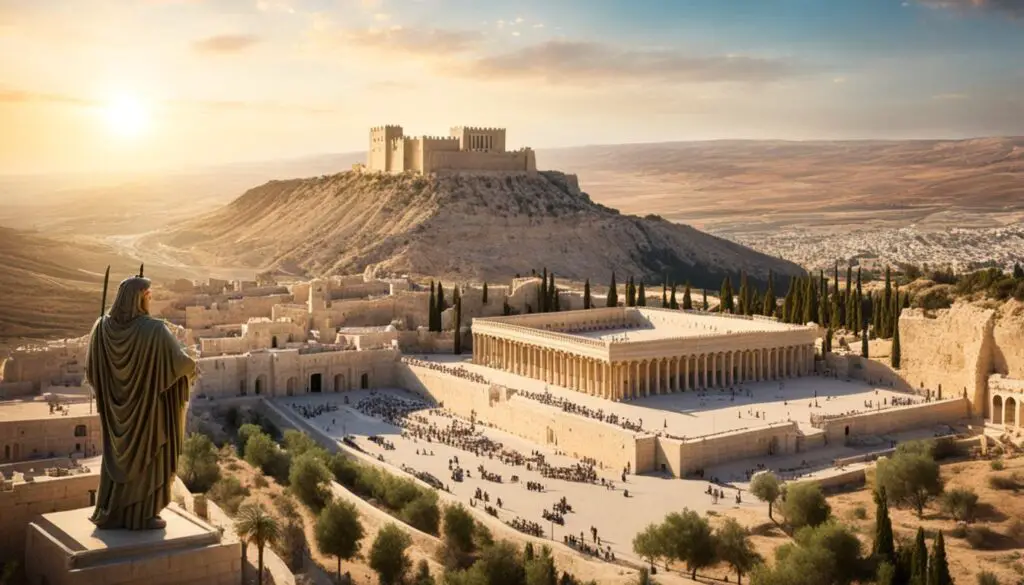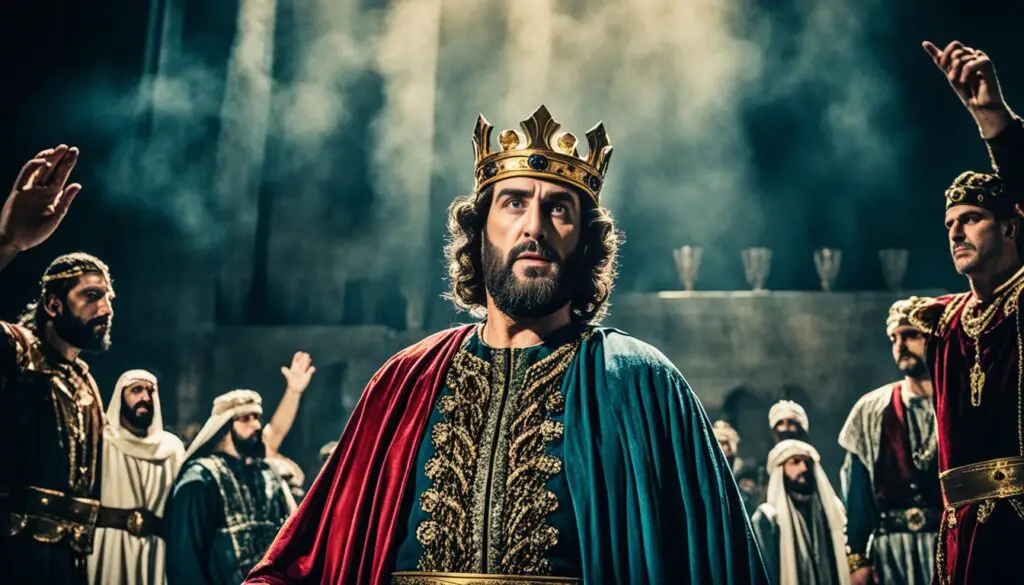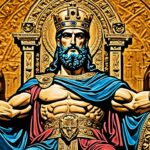King Herod the Great, also known as Herod I, is a prominent figure in the biblical accounts, particularly in the Gospel of Matthew. His reign in the first century BCE has been a subject of fascination and debate, with historians examining the biblical narrative and historical sources to unravel the complexities of his rule.
Herod is known for his colossal building projects, including the magnificent rebuilding of the Second Temple in Jerusalem. His reign, however, is not without controversy, as he ordered the infamous Massacre of the Innocents in an attempt to secure his throne.
In this article, we delve into the biblical account of King Herod the Great, exploring his role in history, his family, his architectural achievements, and his disputed legacy. Join us on this captivating journey into the life and reign of one of the most influential figures in biblical and historical records.
Key Takeaways:
- The biblical accounts offer insight into King Herod the Great’s reign and his significant role in the story of Jesus’ birth.
- Herod’s colossal building projects, including the rebuilding of the Second Temple, showcased his wealth and power.
- The Massacre of the Innocents, ordered by Herod, is a notable event that holds significant biblical significance.
- Historians have differing opinions on Herod’s reign, with some viewing him as a successful ruler and others as a tyrant.
- Recent historical reevaluations have provided a more nuanced understanding of Herod’s life and legacy.
Herod the Great: Life and Family
Herod the Great, born around 72 BCE in Idumea, a region in the south of Judea, was a remarkable ruler whose life and family played a significant role in shaping the history of the region. He was the son of Antipater the Idumaean and Cypros, a Nabatean Arab princess. Although Herod had Arab ancestry from both sides of his family, he was raised as a Jew, reflecting his complex cultural background.
Herod’s path to power began with the support of Rome, which led to his appointment as the governor of Galilee at a young age. His influence and authority increased as he gained the recognition of the Roman Empire. Herod’s family life was also extensive, characterized by multiple wives and numerous children.
| Wives | Children |
|---|---|
| Mariamne I | Alexander, Aristobulus, and others |
| Mariamne II | Herod the Great’s sons from other marriages |
| Doris | Antipater II |
| Cleopatra of Jerusalem | Herod II |
| Malthace | Herod Archelaus and others |
His children from different wives, like Herod Antipas, Herod Archelaus, and Herod Philip, would later assume positions of power and authority, ruling various territories after Herod’s death.
Herod’s diverse lineage and family dynamics played a significant role in shaping his reign and the subsequent political landscape of Judea.
Brief Overview of Herod the Great’s Family:
- Antipater the Idumaean – Father
- Cypros – Mother
- Multiple Wives
- Many Children, including Herod Antipas, Herod Archelaus, and Herod Philip
Herod’s personal and family life complemented his rise to power, ultimately influencing his actions and decisions as a ruler. Understanding the dynamics of his family provides a deeper insight into the complexities of Herod’s reign and the challenges he faced.
Herod’s Reign in Judea
Herod’s reign in Judea marked a new beginning in the history of the region. As a Roman-appointed king, he overthrew the Hasmonean dynasty and established his own Herodian dynasty. This allowed him to rule as a Roman client king, maintaining good relations with Rome while exercising his authority over Judea.
However, Herod’s rule was not without opposition. The Jewish people in Judea distrusted him, as they saw him as a foreign ruler imposed by Rome. This opposition led to numerous conflicts and tensions throughout his reign.
One of the most significant events associated with Herod’s reign, particularly in biblical accounts, is the Massacre of the Innocents. To eliminate a potential threat to his throne, Herod ordered the killing of all male infants in Bethlehem. This event holds immense biblical significance, as it is intertwined with the story of Jesus’ birth and the flight to Egypt.
“A voice is heard in Ramah, weeping and great mourning, Rachel weeping for her children and refusing to be comforted, because they are no more.” – Matthew 2:18
Herod’s reign in biblical history serves as a reminder of the power struggles and political complexities of the time. While his reign brought stability to the region, it also left a trail of bloodshed and controversy.

| Herod’s Reign in Judea | Biblical Significance |
|---|---|
| Overthrow of the Hasmonean dynasty | Highlighted Herod’s ambition and desire for power |
| Establishment of the Herodian dynasty | Marked a new era in Judea’s political landscape |
| Massacre of the Innocents | Illustrated Herod’s ruthless pursuit of maintaining his throne |
| Opposition from the Jewish people | Reflects the tension between foreign rule and religious identity |
Herod’s Building Projects
One of the notable aspects of Herod’s reign was his extensive building projects throughout Judea. He undertook the rebuilding of the Second Temple in Jerusalem, expanding its base to include the Western Wall. He also constructed theaters, amphitheaters, and fortresses. These projects were not only a display of Herod’s power and wealth but also aimed to appease his Roman patrons by bringing the benefits of Roman civilization to the region. His building achievements left a lasting impact on the architectural landscape of Judea.
| Building Projects | Location | Significance |
|---|---|---|
| Rebuilding of the Second Temple | Jerusalem | Expanded base to include the Western Wall; significant religious and cultural importance |
| Theaters and Amphitheaters | Various locations in Judea | Provided venues for entertainment and public gatherings |
| Fortresses | Strategic locations in Judea | Strengthened defenses and secured Herod’s rule |
To emphasize his opulence and demonstrate his loyalty to Rome, Herod’s building projects showcased grandeur and architectural innovation. These structures not only served practical purposes but also shaped the identity and culture of Judea during his reign.

Herod’s Controversial Legacy
Herod’s reign and his actions have a controversial legacy. While he played a significant role in the biblical narrative, particularly in the events surrounding Jesus’ birth, some historians believe that the Massacre of the Innocents may not have actually occurred. His rule was marked by both achievements and ruthless oppression, with some viewing him as a successful ruler and others as a tyrant. The interpretations of his legacy vary depending on historical sources and perspectives.
Historical Perspectives
Herod the Great’s reign evokes diverse interpretations among historians. One viewpoint emphasizes his role in the Biblical account, especially in relation to the birth of Jesus. The Gospel of Matthew recounts Herod’s order to kill all male infants in Bethlehem, known as the Massacre of the Innocents, as he saw Jesus as a potential threat to his reign. However, some historians question the historical accuracy of this event, suggesting that it might be a literary construct rather than a factual occurrence.
“…the slaughter of the infants in Bethlehem does not have a reliable historical foundation but is rather an invention by the early Christians to provide a parallel to the theme of sacrifice reflected in the crucifixion of Jesus.”
Another perspective focuses on Herod’s accomplishments as a ruler, highlighting the grandeur of his building projects and his political alliances. Herod undertook ambitious construction projects, including the rebuilding of the Second Temple in Jerusalem. This architectural feat, completed on an unprecedented scale, remains a testament to his reign. His ability to maintain diplomatic relations with Rome and secure favor from the Roman Empire is further evidence of his political acumen.
Legacy of Controversy
The contrasting views on Herod’s legacy can be attributed to the complexity of his rule. Despite his achievements, Herod’s methods of maintaining control often involved ruthless oppression and violence. He eliminated perceived threats to his power, including members of his own family, through political assassinations. These ruthless actions contribute to his negative portrayal as a tyrant in some historical narratives.
However, it is important to consider the historical context in which Herod ruled. He faced numerous challenges, including balancing the demands of his Roman patrons and the expectations of a Jewish population yearning for independence. His reign occurred during a time of political instability and external threats to Judea. Understanding these complexities can provide a more nuanced perspective on Herod’s approach to governance.
Varied Historical Interpretations
The interpretations of Herod’s legacy are diverse, shaped by the available historical sources and the perspectives of the historians themselves. Some scholars argue that Herod’s achievements and contributions to the region outweigh his tyrannical acts. They see him as a ruler who brought prosperity and stability to Judea through his ambitious building projects and political alliances.
However, others highlight the harshness of his rule and the suffering he inflicted upon those who opposed him. The debates surrounding Herod’s legacy continue to fuel scholarly discussions, with historians endeavoring to uncover the truth behind the myths and legends that surround his reign.

In conclusion, Herod the Great’s legacy remains a topic of debate and interpretation. His reign encompassed both significant achievements and controversial actions, leaving a lasting impact on the historical and biblical narratives. By examining the available historical evidence and considering various perspectives, researchers can continue to unravel the complexities of Herod’s reign and better understand his role in ancient history.
Recent Historical Reevaluations
In recent years, historians have undertaken a comprehensive reevaluation of the reign of King Herod the Great, delving into the wealth of available evidence to gain fresh insights into his life and enduring legacy. This scholarly pursuit has extended beyond the biblical accounts, incorporating archaeological findings and historical sources to provide a more nuanced and objective analysis of Herod’s rule.
This comprehensive reassessment has allowed historians to examine Herod not only as a ruler but also in the context of his political strategies, cultural influences, and social interactions. By considering a wide range of sources, researchers have gained a deeper understanding of his relationship with Rome, his engagement with Jewish and non-Jewish communities, and the impact of his leadership on the region.
The reevaluation of King Herod the Great’s reign has shed new light on his role in biblical narratives and historical events, providing a more informed and comprehensive understanding of his impact on the ancient world.

| Key Findings from Recent Reevaluations | Implications |
|---|---|
| The complexity of Herod’s political strategies | Reveals his skill in navigating Roman and local dynamics |
| Consideration of cultural and social context | Provides insights into the multicultural nature of Herod’s reign |
| Reassessment of historical events and biblical references | Offers a more accurate understanding of Herod’s role in these narratives |
Conclusion
King Herod the Great’s reign was a complex and influential period in the history of Judea. The combination of biblical accounts, historical records, and archaeological findings provides a comprehensive understanding of this enigmatic ruler. Herod’s ambitious building projects, such as the reconstruction of the Second Temple in Jerusalem, testify to his grand vision and desire to leave a lasting mark on the region.
However, Herod’s reign was not without controversy. His conflicts with the Jewish people, including the notorious Massacre of the Innocents, have left a dark stain on his legacy. Despite these tumultuous events, Herod’s involvement in the biblical narrative has made him a key figure in religious and historical studies.
Opinions on Herod the Great’s reign differ among historians, with some recognizing his accomplishments and political astuteness, while others condemn his tyrannical rule. Regardless of varying perspectives, the captivating story of King Herod the Great continues to engage scholars and readers, offering valuable insights into the political and cultural dynamics of ancient Judea.







